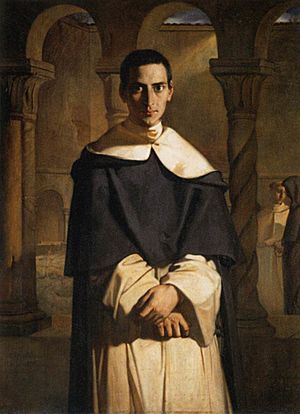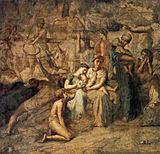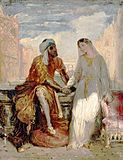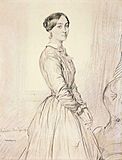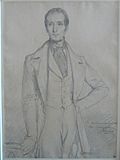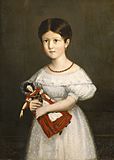Théodore Chassériau facts for kids
Quick facts for kids
Théodore Chassériau
|
|
|---|---|
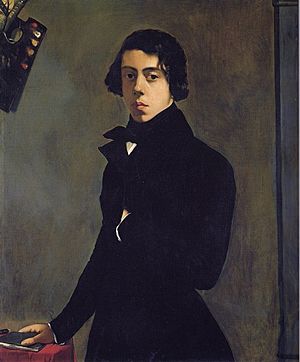
A self-portrait of Chassériau painted at the age of 16
|
|
| Born | September 20, 1819 |
| Died | October 8, 1856 (aged 37) |
| Nationality | French |
| Education | Jean-Auguste-Dominique Ingres |
| Movement | Romanticism; Orientalism |
Théodore Chassériau (September 20, 1819 – October 8, 1856) was a Dominican-born French Romantic painter noted for his portraits, historical and religious paintings, allegorical murals, and Orientalist images inspired by his travels to Algeria. Early in his career he painted in a Neoclassical style close to that of his teacher Jean-Auguste-Dominique Ingres, but in his later works he was strongly influenced by the Romantic style of Eugène Delacroix. He was a prolific draftsman, and made a suite of prints to illustrate Shakespeare's Othello. The portrait he painted at the age of 15 of Prosper Marilhat, makes Théodore Chassériau the youngest painter exhibited at the Louvre museum.
Life and work
Chassériau was born in El Limón, Samaná, in the Spanish colony of Santo Domingo (now the Dominican Republic). His father Benoît Chassériau was a French adventurer who had arrived in Santo Domingo in 1802 to take an administrative position in what was until 1808 a French colony. Theodore's mother, Maria Magdalena Couret de la Blagniére, was the daughter of a mulatto landowner born in Saint-Domingue (now Haiti). In December 1820 the family left Santo Domingo for Paris, where the young Chassériau soon showed precocious drawing skill. He was accepted into the studio of Jean-Auguste-Dominique Ingres in 1830, at the age of eleven, and became the favorite pupil of the great classicist, who regarded him as his truest disciple. (An account that may be apocryphal has Ingres declaring "Come, gentlemen, come see, this child will be the Napoleon of painting.")
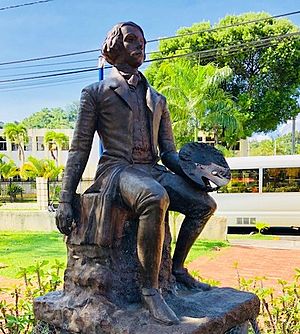
After Ingres left Paris in 1834 to become director of the French Academy in Rome, Chassériau fell under the influence of Eugène Delacroix, whose brand of painterly colorism was anathema to Ingres. Chassériau's art has often been characterized as an attempt to reconcile the classicism of Ingres with the romanticism of Delacroix. He first exhibited at the Paris Salon in 1836, and was awarded a third-place medal in the category of history painting. In 1840 Chassériau travelled to Rome and met with Ingres, whose bitterness at the direction his student's work was taking led to a decisive break. While in Italy, Chassériau made landscape sketches and studied Renaissance frescoes.
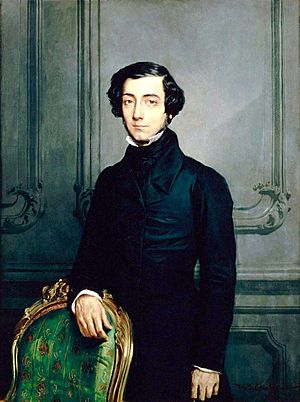
Among the chief works of his early maturity are Susanna and the Elders and Venus Anadyomene (both 1839), Diana Surprised by Actaeon (1840), Andromeda Chained to the Rock by the Nereids (1840), and The Toilette of Esther (1841). Chassériau's major religious paintings from these years, Christ on the Mount of Olives (a subject he treated in 1840 and again in 1844) and The Descent from the Cross (1842), received mixed reviews from the critics; among the artist's champions was Théophile Gautier. In 1843, Chassériau painted murals depicting the life of Saint Mary of Egypt in the Church of Saint-Merri in Paris, the first of several commissions he received to decorate public buildings in Paris.
Portraits from this period include the Portrait of the Reverend Father Dominique Lacordaire, of the Order of the Predicant Friars (1840), and The Two Sisters (1843), which depicts Chassériau's sisters Adèle and Aline.
Throughout his life he was a prolific draftsman; his many portrait drawings executed with a finely pointed graphite pencil are close in style to those of Ingres. He also created a body of 29 prints, including a group of eighteen etchings of subjects from Shakespeare's Othello in 1844.
He exhibited the colossal portrait Ali-Ben-Hamet, Caliph of Constantine and Chief of the Haractas, Followed by his Escort in the Salon of 1845, where it received equivocal reviews. In 1846, Chassériau made his first trip to Algeria. From sketches made on this and subsequent trips he painted such subjects as Arab Chiefs Visiting Their Vassals and Jewish Women on a Balcony (both 1849, now in the Louvre). A major late work, The Tepidarium (1853, in the Musée d'Orsay), depicts a large group of women drying themselves after bathing, in an architectural setting inspired by the artist's trip in 1840 to Pompeii. His most monumental work was his decoration of the grand staircase of the Cour des Comptes, commissioned by the state in 1844 and completed in 1848. He followed the example of Delacroix in executing this work in oil on plaster, rather than in fresco. This work was heavily damaged in May 1871 by a fire set during the Commune, and only fragments could be recovered; these are preserved in the Louvre.
After a period of ill health, exacerbated by his exhausting work on commissions for murals to decorate the Churches of Saint-Roch and Saint-Philippe-du-Roule, Chassériau died at the age of 37 in Paris, on October 8, 1856. He is buried in the Montmartre Cemetery.
Legacy
His work had a significant impact on the style of Puvis de Chavannes and Gustave Moreau, and—through those artists' influence—reverberations in the work of Paul Gauguin and Henri Matisse. There is in Paris a Society for the painter: Association des Amis de Théodore Chassériau.
Works of Chassériau are in the Musée du Louvre where a room is dedicated to him, in the Musée d'Orsay, and in the Musée de Versailles. Collections in the United States holding works by Théodore Chassériau include the Metropolitan Museum of Art, New York, the Fogg Art Museum of Harvard University, the National Gallery of Art of Washington, D.C., the Detroit Institute of Arts, the Museum of the Art Rhode Island School of Design, The J. Paul Getty Museum and the Art Institute of Chicago.
Exhibitions
- Théodore Chassériau: Parfum exotique, National Museum of Western Art of Tokyo, Japan, February 28 – May 28, 2017
- Théodore Chassériau: Obras sobre papel, Galerie nationale des beaux-arts de Santo Domingo and Centro cultural León de Santiago de los Caballeros, Dominican Republic, 2004
- Théodore Chassériau (1819–1856): A Different Romanticism, Metropolitan Museum of Art, New York (United States), Galeries nationales du Grand Palais in Paris (France) and Musée des beaux-arts de Strasbourg (France), 2002
- Chassériau (1819–1856): exposition au profit de la Société des amis du Louvre, Galerie Daber, Paris, France, 1976
- Theodore Chassériau (1819–1856), Musée des beaux-arts de Poitiers, France, 1969
- Théodore Chassériau, Musée national des beaux-arts d'Alger, Algeria, 1936
- Restrospective Théodore Chassériau (1819–1856), Musée de l'Orangerie, Paris, France, 1933
- Aquarelles et dessins de Chasseriau (1819–1856), Galerie L. Dru, Paris, France, 1927
- Les Peintres orientalistes français - 4e exposition: Rétrospective Théodore Chassériau, Galerie Durand-Ruel, Paris, France, 1897
Selected works
- Self-portrait - Musée du Louvre
- Aline Chassériau - Musée du Louvre
- Battle of Arab Horsemen Around a Standard (1854) - Dallas Museum of Art
- The Caliph of Constantine, also known as Ali Ben-Hamet, Caliph of Constantine and Chief of the Haractas, Followed by his Escort
- Arab Chiefs Challenging each other to Single Combat under the Ramparts of a City
- Andromeda Chained to the Rock by the Nereids
- Arab Chiefs Visiting their Vassals
- Christ on the Mount of Olives
- The Descent from the Cross
- Diana Surprised by Actaeon
- Jewish Women on a Balcony
- Othello and Desdemona in Venice
- Portrait of the Father Dominique Lacordaire, of the Order of the Predicant Friars
- Susanna and the Elders
- Venus Anadyomene
- The Tepidarium
- The Toilette of Esther
- The Two Sisters
Gallery
-
Portrait de la comtesse de La Tour Maubourg, 1841, Metropolitan Museum of Art, New York
-
Othello and Desdemona in Venice, 1850, oil on wood, 25 x 20 cm, Louvre, Paris. Another work inspired by Shakespeare
-
Scene in the Jewish Quarter of Constantine, 1851, Metropolitan Museum of Art, New York
-
Portrait d'Alphonse de Lamartine, 1844, pencil on paper
See also
 In Spanish: Teodoro Chassériau para niños
In Spanish: Teodoro Chassériau para niños
- Léonce Bénédite
- List of Orientalist artists
- Orientalism



